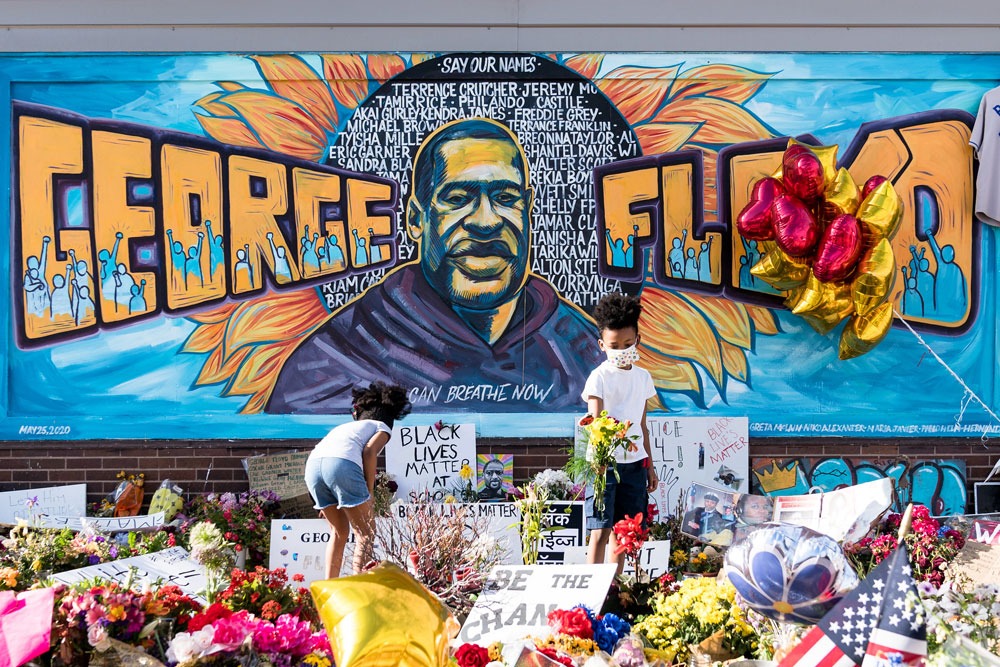
June 19, 2020; Detroit Free Press
In the days after George Floyd was killed by police in Minneapolis, his likeness began appearing in murals across the US to honor his memory and to demand justice for Floyd and the oh-so-many other Black lives senselessly lost in horribly similar ways. As reported in Colossal, murals bearing images of Floyd can be found in cities including Minneapolis, Los Angeles, and Fayetteville (Arkansas); as well as in Berlin, Dublin, and Syria (the latter on a fragment of wall from a building that’s been destroyed). One artist quickly designed typographic banners with Floyd’s last words—“Please I can’t breathe,” “My neck hurts,” and “They’re going to kill me”—that were flown over Detroit, Miami, Dallas, Los Angeles, and New York.
Over the last month, artists—including many muralists—have stepped up to advance the work of the Black Lives Matter movement and to help communities reclaim their spaces. In doing so, they’ve found ways to engage others, including many young people. Local governments have even taken part in some cases, at times initiating work that now unavoidably dominates public spaces which have not been owned or experienced as safe by Black people or people of color.
Following are several examples (we know there are countless others) of initiatives meant to celebrate, to mourn, to retake, and to keep the collective consciousness about our national mandate for racial justice moving steadily forward. Some come established artists, some from activists, and some from local public officials—and sometimes they are led by all three.
In Philadelphia, arts educator Samuel Rodriguez saw boarded-up buildings in the city as an opportunity to advocate for positive change, as reported in Billy Penn. With help from more than 100 volunteers—some artists, and some just willing hands—Rodriguez has led the effort to paint messages of encouragement on the temporary surfaces of damaged storefronts. Called “Walls for Justice,” the initiative engages business owners in selecting messages that fit both the store and the moment we are in. For example, the owner of heavily damaged Philly Runner, Ross Martinson, chose a quote from Martin Luther King, Jr.: “If you can’t fly, run; if you can’t run, walk; if you can’t walk, crawl.”
Sign up for our free newsletters
Subscribe to NPQ's newsletters to have our top stories delivered directly to your inbox.
By signing up, you agree to our privacy policy and terms of use, and to receive messages from NPQ and our partners.
In Montgomery, artist and business owner Michelle Browder got permission to paint a temporary mural for Juneteenth on the sidewalk surrounding a downtown fountain. The location is saturated with significance. It is the former site of the city’s slave market. A statue there marks the spot where Rosa Parks began her famous bus ride in 1955, and the square sits at the foot of Dexter Avenue, where the 1965 Selma-to-Montgomery voting rights march ended. Browder enlisted the help of several other artists and completed the project in less than two days. (We can only hope the Powers That Be opt for a more permanent version of this sidewalk mural.)
When Washington, DC, mayor Muriel Bowser renamed a section of Pennsylvania Avenue “Black Lives Matter Plaza” in early June and had the words “Black Lives Matter” painted along several city blocks, she started a national trend. As described in a recent New Yorker article, “The pavement itself has become part of the protest.” That article references similar murals in Oakland (Black Lives Matter) and Raleigh (End Racism Now).
Other new street murals include these:
- In Jackson, Michigan, artists and volunteers spent all day last Friday painting a Black Lives Matter street mural, then joined the city’s Juneteenth block party. The letters of the mural will be filled in later with paintings by artists as a second phase of the project.
- Grambling, Louisiana, now has a street mural in front of city hall that reads “Black Towns Matter.” Mayor Edward Jones hopes it will help people appreciate “the importance of towns and settlements established by black people.”
- Detroit has a block-long street mural with the message “Power to the People.” The image was designed by well-known muralist and teacher Dr. Hubert Massey and executed with the help of 20 student artists from local public schools and from the nonprofit Detroit Heals Detroit. As reported in the Detroit Free Press, the city’s director of arts and culture, Rochelle Riley, commented on the impact of the project on the students: “I have not seen such joy. These kids are magical, smart, astute and they know how powerful this is. They talked about being a part of making history and I was so proud to watch them work.”
Murals and other public works of art are not always universally appreciated or protected, and these new efforts to support the Black Lives Matter movement are not without their detractors. A news report in Fayetteville about the George Floyd mural noted that critics began voicing objections through social media almost before the paint had dried. And a George Floyd mural in Brownsville, Texas—with an image of Floyd’s face and butterflies to suggest his passing and to make the mural accessible to children—already has been vandalized. Don’t worry, it will be repainted, as local artist Marcus Castro has announced. In fact, Castro is confident the second iteration of his work will be even better than the first—so confident, in fact, that he offered this message to the vandal: “Thank you very much because it actually inspired me to do something that’s better and to do it again.”—Eileen Cunniffe











